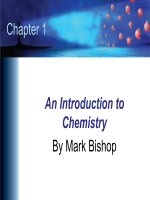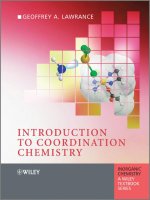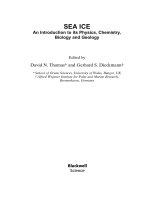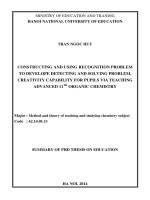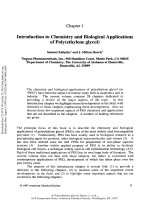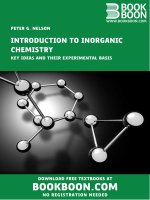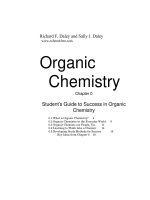Introduction to organic chemistry
Bạn đang xem bản rút gọn của tài liệu. Xem và tải ngay bản đầy đủ của tài liệu tại đây (2.33 MB, 91 trang )
21
21.1
21.2
21.3
21.4
1
1
Introduction to
Organic Chemistry
What is Organic Chemistry?
The Unique Nature of Carbon
Classification of Organic Compounds
Factors Affecting the Physical Properties of
Organic Compounds
New Way Chemistry for Hong Kong A-Level Book 3A
21.
1
What is
Organic
Chemistry?
2
2
New Way Chemistry for Hong Kong A-Level 3A
New Way Chemistry for Hong Kong A-Level Book 3A
21.1 What is Organic Chemistry (SB p.2)
Organic Chemistry
3
3
•
Chemistry of the compounds present
in living organisms.
•
They all contain carbon.
•
Organic Chemistry is the Chemistry
of Carbon.
New Way Chemistry for Hong Kong A-Level 3A
New Way Chemistry for Hong Kong A-Level Book 3A
21.1 What is Organic Chemistry (SB p.4)
Natural Sources of Organic Compounds
Living
things
Carbohydrates /
Proteins / Fats /
Vitamins /
Antibiotics
A variety of
organic products
obtained from
living things
4
4
New Way Chemistry for Hong Kong A-Level 3A
New Way Chemistry for Hong Kong A-Level Book 3A
21.1 What is Organic Chemistry (SB p.4)
Natural Sources of Organic Compounds
Crude oil
or coal
Fractional distillation /
destructive distillation
Alkanes /
Alkenes /
Alkynes /
Aromatic
hydrocarbons
Check Point 21-1
5
5
A variety of
useful products
derived from
crude oil and coal
New Way Chemistry for Hong Kong A-Level 3A
New Way Chemistry for Hong Kong A-Level Book 3A
21.1 What is Organic Chemistry (SB p.3)
Development of Organic Chemistry
as a Science
In the past
…,
Chemistry
Chemistry
Organic
Organic
compounds
compounds
obtained from
living organisms
6
6
Inorganic
Inorganic
compounds
compounds
obtained from
non-living sources
New Way Chemistry for Hong Kong A-Level 3A
New Way Chemistry for Hong Kong A-Level Book 3A
21.1 What is Organic Chemistry (SB p.3)
Development of Organic Chemistry
as a Science
In 1828, Wohler (a German chemist)
(Inorganic
compound)
7
7
(Organic
compound)
New Way Chemistry for Hong Kong A-Level 3A
New Way Chemistry for Hong Kong A-Level Book 3A
21.1 What is Organic Chemistry (SB p.3)
Development of Organic Chemistry
as a Science
Redefining … ...
Organic chemistry
chemistry is
is the
the study
study of
of carbon
carbon
Organic
compounds (except
(except CO,
CO, CO
CO22,, carbonates,
carbonates,
compounds
hydrogencarbonates, carbides
carbides and
and
hydrogencarbonates,
cyanides) obtained
obtained from
from natural
natural sources
sources or
or
cyanides)
synthesized in
in the
the laboratories.
laboratories.
synthesized
8
8
New Way Chemistry for Hong Kong A-Level 3A
New Way Chemistry for Hong Kong A-Level Book 3A
21.
2 The Unique
Nature of
Carbon
9
9
New Way Chemistry for Hong Kong A-Level 3A
New Way Chemistry for Hong Kong A-Level Book 3A
21.2 The Unique Nature of Carbon (SB p.5)
Ability to form four strong covalent bonds
• Electronic configuration of carbon
(ground state) : 1s22s22p2
Carbon (ground state)
10
10
New Way Chemistry for Hong Kong A-Level 3A
New Way Chemistry for Hong Kong A-Level Book 3A
21.2 The Unique Nature of Carbon (SB p.5)
Ability to form four strong covalent bonds
• Each carbon atom has four unpaired
electrons when excited
• Tend to form four strong covalent bonds
Carbon (excited state)
11
11
New Way Chemistry for Hong Kong A-Level 3A
New Way Chemistry for Hong Kong A-Level Book 3A
21.2 The Unique Nature of Carbon (SB p.5)
Ability to Catenate
• Carbon atoms link together to form
chains of varying length, branched
chains and rings of different sizes
• Catenation:
Ability of atoms in forming stable
bonds with itself, hence joining up
into chains or rings
12
12
New Way Chemistry for Hong Kong A-Level 3A
New Way Chemistry for Hong Kong A-Level Book 3A
21.2 The Unique Nature of Carbon (SB p.5)
Ability to Catenate
C – C > Si – Si > Ge – Ge > Sn – Sn
Bond strength ↓ as bond length ↑
13
13
New Way Chemistry for Hong Kong A-Level 3A
New Way Chemistry for Hong Kong A-Level Book 3A
21.2 The Unique Nature of Carbon (SB p.5)
Ability to Catenate
C–C>N–N>O–O
Bond strength ↓
as the number of lone pairs ↑
14
14
New Way Chemistry for Hong Kong A-Level 3A
New Way Chemistry for Hong Kong A-Level Book 3A
21.2 The Unique Nature of Carbon (SB p.5)
Ability to Catenate
15
15
CnH2n+2
n = 1,2,3,…(no limit for n)
SinH2n+2
n = 1 to 6 only → silanes
GenH2n+2
n = 1 to 3 only → germanes
SnnH2n+2
Only SnH4 (stannane) exists
New Way Chemistry for Hong Kong A-Level 3A
New Way Chemistry for Hong Kong A-Level Book 3A
21.2 The Unique Nature of Carbon (SB p.5)
Ability to Form Multiple Bonds
sp3
sp2
sp
4σ bonds
1π bond, 3σ bonds
2π bonds, 2σ bonds
Carbon (excited state)
16
16
New Way Chemistry for Hong Kong A-Level 3A
New Way Chemistry for Hong Kong A-Level Book 3A
21.2 The Unique Nature of Carbon (SB p.6)
Single bond
Double bond
Triple bond
* X = halogens
17
17
New Way Chemistry for Hong Kong A-Level 3A
New Way Chemistry for Hong Kong A-Level Book 3A
21.2 The Unique Nature of Carbon (SB p.6)
Example 21-2
18
18
Check Point 21-2
New Way Chemistry for Hong Kong A-Level 3A
New Way Chemistry for Hong Kong A-Level Book 3A
21.
3Classification
of Organic
Compounds
19
19
New Way Chemistry for Hong Kong A-Level 3A
New Way Chemistry for Hong Kong A-Level Book 3A
21.3 Classification of Organic Compounds (SB p.7)
Functional Groups
•
20
20
Organic compounds are classified by
the the presence of characteristic
functional groups.
New Way Chemistry for Hong Kong A-Level 3A
New Way Chemistry for Hong Kong A-Level Book 3A
21.3 Classification of Organic Compounds (SB p.7)
Functional Groups
A functional
functional group
group is
is defined
defined as
as an
an
A
atom or
or aa group
group of
of atoms
atoms that
that
atom
effectively determines
determines the
the chemical
chemical
effectively
properties of
of an
an organic
organic compound.
compound.
properties
21
21
New Way Chemistry for Hong Kong A-Level 3A
New Way Chemistry for Hong Kong A-Level Book 3A
21.3 Classification of Organic Compounds (SB p.7)
Functional Groups
22
22
New Way Chemistry for Hong Kong A-Level 3A
New Way Chemistry for Hong Kong A-Level Book 3A
21.3 Classification of Organic Compounds (SB p.7)
Functional Groups
23
23
•
Propane does not react with sodium
•
Ethanol and propan-1-ol react with
sodium to give hydrogen gas
New Way Chemistry for Hong Kong A-Level 3A
New Way Chemistry for Hong Kong A-Level Book 3A
21.3 Classification of Organic Compounds (SB p.7)
Functional Groups
and
• have similar chemical properties
they contain the same functional group –OH
they are classified into the same
homologous series — alcohols
24
24
New Way Chemistry for Hong Kong A-Level 3A
New Way Chemistry for Hong Kong A-Level Book 3A
21.3 Classification of Organic Compounds (SB p.12)
Homologous Series
A homologous
homologous series
series is
is aa series
series of
of
A
compounds that
that have
have the
the same
same functional
functional
compounds
group, and
and each
each member
member differs
differs from
from
group,
the next
next member
member by
by aa –– CH
CH22 –– unit
unit in
in
the
their formulae.
formulae.
their
CH4
C2 H 6
CH2
25
25
C3H8
CH2
C4H10
CH2
New Way Chemistry for Hong Kong A-Level 3A
New Way Chemistry for Hong Kong A-Level Book 3A



